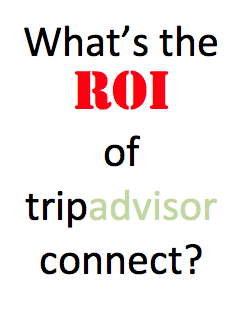Lead Generation – Nurturing
A Likely TripAdvisor Connect Scenario
Let’s cut through all the noise of the upcoming TripAdvisor Connect announcement with a real life example of a likely TripAdvisor Connect scenario. In last week’s post, Rolling Out TripAdvisor Connect, we dissected the FAQ posted by Trip Advisor and speculated a bit on what’s to come based on what industry insiders are discussing. What will…
Read More5 Stages of Choosing Travel
The travel outlook is positive, and with the rise of mobile, social and video behaviors, we are now seeing seeing travelers move through five key stages of travel. Here are some insights within each stage: Dreaming: 68% of business travelers watch travel-related online videos. Among them, 68% are thinking about a trip. Planning: The average…
Read MoreIt’s Self-Evaluation Time for your Website
As you know, your website is your online basecamp. It conveys the essence of your brand to your community and is the heavy-lifter for all of your online communications. If it lacks appeal, is unorganized, or just doesn’t work properly, it can lead to lost business opportunities, perhaps even business failure. So what have you got…
Read MoreWho Should Be Your Next ‘Go To’ Employee?
“So I have a website –now what?” That is the question I often get when a client is asking why the website they either made themselves or ‘had a friend’ design isn’t getting any results. And I mean it –ANY RESULTS. So many small business owners are not getting the point. A website is only…
Read MoreThe Secret is in Breaking the Chicken and Egg Problem
I found this BNET blog article interesting. BNET interviewed Ceriac Roeding of Shopkick and he discussed the ‘Catch 22’ facing many entrepreneurs. How do you establish that first base of business? Credibility struggles with success. You have to make someone actually BELIEVE. He cited examples he learned through his startup, Shopkick. These examples are transferable to many small…
Read MoreDynamic Websites and What They Mean For Your Small Business
There are a lot of people out there suggesting that a small business owner can create their website overnight. And you can. But will it do what you want it to do? photo © 2007 Ben Zvan | more info (via: Wylio) What exactly do you want it to do? Are you happy with a…
Read MoreHow Small Businesses Get the Most from Social Media
Just how are small businesses using social media? What level of online presence should you have? One way to start is to review what other small business owners are doing and model it after them. Once again our friends at Mashable! have provided some insights in their latest Infographics report. In a nutshell, here’s what…
Read MoreDispatches from Blogistan, A Book Review
Described in the subtitle as “a travel guide for the modern blogger,” Suzanne Stefanac’s book, Dispatches from Blogistan, is worth reading whether you are a blogger or not. This is not so much a how-to book as it is a why-to-blog book. The first two chapters offer a new take on the history of communications. And…
Read MoreOnline FREE, the new Tchochtke
Henry Ford once said, “The man who will use his skill and constructive imagination to see how much he can give for a dollar, instead of how little he can give for a dollar, is bound to succeed.” In today’s inbound marketing terms, this could be the new Holy Grail. Business owners successful at providing…
Read MoreKnow Your Customer’s Customer
One of the basic principles of customer satisfaction is to understand and know your customer’s customer. It is something so simple, and yet sometimes, marketing professionals overlook this. Instead they create campaigns that fit the marketing person’s profile or fancy better than they do the customer or the customer’s customer. Whether you’re selling to a company that…
Read More

